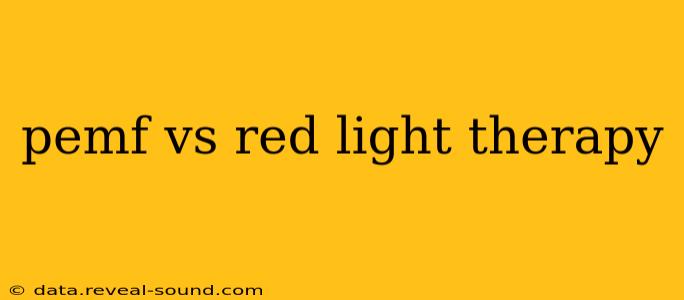Both Pulsed Electromagnetic Field therapy (PEMF) and red light therapy (RLT) are gaining popularity as alternative therapies for various health concerns. However, they operate on entirely different principles and target different aspects of cellular function. Understanding these differences is crucial in determining which therapy, or combination, might be most beneficial for you. This article will delve into the mechanisms, applications, and potential benefits of each therapy, addressing common questions to help you make an informed decision.
What is Pulsed Electromagnetic Field (PEMF) Therapy?
PEMF therapy uses electromagnetic fields to stimulate cells in the body. These pulsed electromagnetic fields are non-invasive and generate weak electromagnetic pulses that penetrate the body's tissues, reaching even bone and muscle. The theory behind PEMF therapy is that these pulses improve cellular function by influencing cellular processes like ATP production (energy) and reducing inflammation.
How Does PEMF Therapy Work?
PEMF devices generate fluctuating magnetic fields that induce small electrical currents within the body. These currents are believed to stimulate cellular repair mechanisms, increase blood circulation, and reduce inflammation. While the exact mechanisms aren't fully understood, research suggests it may impact cellular processes at a fundamental level.
What is Red Light Therapy (RLT)?
Red light therapy, also known as low-level laser therapy (LLLT), uses low-level wavelengths of red and near-infrared (NIR) light to stimulate cellular activity. This light penetrates the skin and interacts with photoreceptors within the cells, triggering various biological responses.
How Does Red Light Therapy Work?
The light energy from RLT is absorbed by the mitochondria (the powerhouses of cells), potentially increasing ATP production and improving cellular metabolism. This increased cellular activity is believed to lead to reduced inflammation, pain relief, faster wound healing, and improved skin appearance.
PEMF vs. Red Light Therapy: Key Differences
| Feature | PEMF Therapy | Red Light Therapy |
|---|---|---|
| Mechanism | Electromagnetic fields induce electrical currents | Light energy absorbed by mitochondria |
| Penetration | Deeper penetration, reaching bone and muscle | Primarily affects surface tissues and skin |
| Treatment Area | Can treat larger areas of the body | More localized treatment |
| Application | Mats, pads, or localized devices | Handheld devices, panels, or masks |
| Side Effects | Generally considered safe, but some may experience mild sensations | Generally safe, potential for temporary redness or mild warmth |
What are the potential benefits of PEMF therapy?
PEMF therapy is explored for a variety of health conditions. Research suggests potential benefits including:
- Pain Management: Reducing pain associated with various conditions.
- Improved Sleep: Regulating the body's natural sleep-wake cycle.
- Increased Energy Levels: Boosting ATP production for improved cellular function.
- Reduced Inflammation: Decreasing inflammation throughout the body.
- Bone Healing: Supporting bone growth and repair.
What are the potential benefits of Red Light Therapy?
RLT also has a wide range of potential applications:
- Wound Healing: Accelerating the healing process of wounds and injuries.
- Skin Rejuvenation: Improving skin texture, reducing wrinkles, and promoting collagen production.
- Pain Relief: Reducing pain in muscles and joints.
- Hair Growth: Stimulating hair follicles to promote hair growth.
- Acne Treatment: Reducing inflammation and promoting healing of acne lesions.
Can I use PEMF and Red Light Therapy together?
There's no known contraindication against using PEMF and RLT together. In fact, some believe that the combined effects of these therapies could be synergistic, offering enhanced benefits. However, it's crucial to consult with a healthcare professional before combining therapies, especially if you have pre-existing health conditions.
Which therapy is right for me?
The choice between PEMF and RLT depends largely on your specific health concerns and goals. If you're looking for deep tissue penetration and treatment of larger areas of the body, PEMF might be a better option. If you're primarily concerned with skin conditions or localized pain relief, RLT could be more effective. A consultation with a healthcare professional can help determine the most appropriate therapy for your individual needs.
Is PEMF therapy safe?
PEMF therapy is generally considered safe, with minimal side effects reported. However, individuals with pacemakers or other implanted electronic devices should avoid PEMF therapy. Pregnant women should also consult their doctor before undergoing treatment.
Is Red Light Therapy safe?
Red light therapy is also generally safe, but individuals with certain medical conditions, such as porphyria, should avoid it. It's always best to consult with a healthcare professional before starting any new therapy.
This information is for educational purposes only and is not a substitute for professional medical advice. Always consult with a qualified healthcare provider before starting any new treatment.
